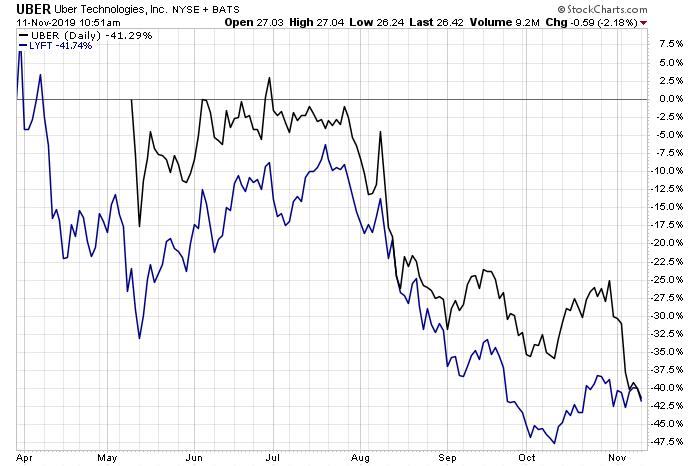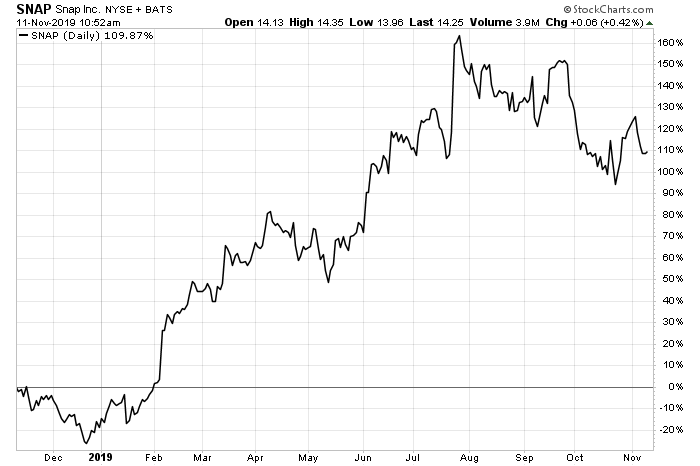UBER Stock: How Investors Can Double Their Investment in Uber
Marijuana Business, Stocks, Finance, & Investing November 13, 2019 MJ Shareholders 0


Uber Stock Resurgence
“Unqualified disaster” would be an apt description of ride-sharing app stocks so far. Both Uber Technologies Inc (NYSE:UBER) and Lyft Inc (NASDAQ:LYFT) are down about 40% post-initial public offering (IPO). Neither stock has showed a small glimpse of life since going public.
In fact, ride-sharing app stocks have had a sordid start to their lives on the public market. But, as the old adage goes, “buy low and sell high.” As such, now could be the perfect time to consider Uber stock and Lyft stock.
Although the following is mainly concerned with Uber, I feel that much of it is also applicable to Lyft.
Uber stock and Lyft stock are in very similar positions, with the difference perhaps being of degree. Uber is significantly larger than Lyft, with almost four times as much market cap.
As seen in the below chart, both ride-sharing app stocks have plummeted since going public.
Chart courtesy of StockCharts.com
There are myriad reasons why Uber stock and Lyft stock sunk so fast and so deep, but the primary one is easy to understand: fear. Investors fear that these companies are years away from profitability—or that they will never be profitable.
Now, I don’t share that concern. Maybe Uber shouldn’t have a $46.3-billion market cap, but market cap notwithstanding, Uber is a simple app that millions of people use every day around the world. With that foundation alone, there’s lots of money to be made from Uber.
And then of course there’s all the ancillary pursuits of the company, like self-driving cars, which could erase Uber’s major cost: paying its drivers.
But that’s more of a moonshot scenario that would be better discussed in the years to come. Right now, what’s important is that investors have been fleeing Uber in droves.
Travis Kalanick, current director and former CEO of Uber (not to mention co-founder), just sold off 20% of his holdings in the company after a 180-day lockup. This netted the billionaire a tidy sum of about $547.0 million and leaves him with a 4.6% share of Uber Technologies Inc. (Source: “Travis Kalanick Sells 20% of His Stake in Uber After Lockup,” Bloomberg, November 11, 2019.)
What this signals to investors is that, if the billionaires are getting out, things are bad. Worse yet, this is not a random billionaire; this is a billionaire shareholder who also happened to found the company.
If he’s losing faith, well, you don’t have to be a investment wiz to sense that things are going sour.
Kalanick may not currently have the warmest of feelings toward the company he birthed. After all, he was forced out after a string of controversies involving him made it impossible to keep him on.
Kalanick has a notoriously big mouth, but he’s also no fool. After losing nearly half the value of his Uber investment in the past few months, he wanted to cash out as soon as possible, culminating in that big payout.
So things look bleak for Uber stock in the short term, but that’s precisely why I’m bullish on the long-term projection.
SNAP Stock Example
In order to understand why I believe that Uber stock can double an investors’ money in the coming years, we have to look at Snap Inc (NYSE:SNAP).
The social media company also had a hot IPO that was closely watched. With Snap stock, many investors were worried about possibly missing out on the next Facebook, Inc. (NASDAQ:FB).
But much like Uber, Snap proved to be bloated upon entering the public market, with many investors concerned about the company’s path to profitability.
Meanwhile, Snap Inc could only promise business growth. Growth is great, but without a reliable model to produce profits, growth is a shaky foundation on which to build a company.
Worse yet, no growth springs eternal, and when Snap Inc ran into a few hiccups, Snap stock plunged.
It’s a lesson that Uber investors (and really, all investors) should take to heart: profitability is king. All the talk about growth is well and good, but you need to make money to have a strong company.
This fundamental idea seems to have been lost in recent times, but it’s no less true today than it was in yesteryear.
But Snap also shows investors a path to profitability. While Snap stock may have lost its day-one investors about 16% from its IPO price in 2017, those who invested a year ago have doubled their money, as seen in the below chart.
The reason is simple: those investors bought the dip.
Chart courtesy of StockCharts.com
Snap has value, much like Uber has (tremendous) value.
Is Uber bloated? Absolutely. That’s why we’re seeing the current fall in its share price. But much like Snap stock, Uber stock has the ability to hit a nadir and then claw its way up to become a very lucrative stock.
The question, as is usually the case when it comes to the stock market, is timing. When would be the best time to invest in Uber?
Right now the stock is on a downswing, no doubt about that. And I believe that it could fall a good bit more.
But within the year, I project that Uber stock will hit its bottom. And when it does, investors who are able to nab shares will likely see their investment grow exponentially if history holds.
It’s all a matter of Uber hitting a point where investors feel comfortable with its share price again. I’d put that point anywhere between 50% and 75% below the Uber IPO price.
Once the stock price hits those low numbers, investors will have a fantastic opportunity to buy on the dip a stock that, all things considered, still has a ton of potential.
Uber is an immensely popular service with millions of customers around the planet, some of whom use the service every day.
Analyst Take
Uber stock has massive potential waiting to be tapped into, for those who are willing to wait and time their investment just right.
What the market needs is calibration. Once shares of Uber Technologies Inc hit their appropriate price, they will be ready to explode.
MJ Shareholders
MJShareholders.com is the largest dedicated financial network and leading corporate communications firm serving the legal cannabis industry. Our network aims to connect public marijuana companies with these focused cannabis audiences across the US and Canada that are critical for growth: Short and long term cannabis investors Active funding sources Mainstream media Business leaders Cannabis consumers












No comments so far.
Be first to leave comment below.